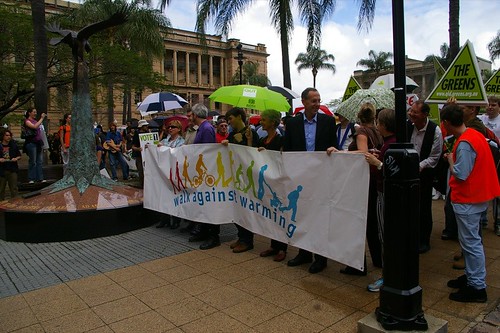Anne Davies State Political Editor
November 28, 2006
From Sydney Morning Herald
THE climate-change impacts of new industries, including burning coal extracted from NSW mines, will have to be considered by the State Government following a landmark judgement yesterday.
The court victory for a 26-year-old environmental activist, Peter Gray, has put another hurdle in the way of Centennial Coal's giant Anvil Hill coalmine, planned for the Upper Hunter. While the decision, delivered in the Land and Environment court, does not block the mine's development entirely, Justice Nicola Pain ruled that a crucial step - the director-general of planning's acceptance of the environmental assessment - was flawed and invalid.
The Government will now have to take account of the greenhouse gas emissions from burning the mine's output - even though 80 per cent will be exported.
And the case is likely to have ramifications far beyond Anvil Hill. All greenhouse gas producing developments will now be required to include an assessment of their contribution to global warming. This could include coal mines, steel mills, electricity plants, and even new tollways.
The environmental impact statement for the mine may have to be re-exhibited, although government sources said last night they believed this could be avoided. Alternatively, the Government could appeal, although the Premier declared this week that he intended to make climate change a big issue in the coming election campaign.
"I consider there is a sufficiently proximate link between the mining of a very substantial reserve of thermal coal in NSW, the only purpose of which is for use as fuel in power stations, and the emissions of GHG [greenhouse gas] which contribute to climate change/global warming."
It was clear that climate change was affecting the Australian and NSW environments and this meant the burning of coal had to be considered in the environmental assessment process. The judge pointed to legislation requiring the Planning Department to encourage ecologically sustainable development.
According to the Government's own secret assessment, which came to light during the case, the 10.5 million tonnes of coal from Anvil Hill, when burnt, would produce 12.5 million tonnes of carbon dioxide a year - equivalent to doubling the number of cars on NSW roads to 8 million.
Mr Gray, the activist from Newcastle, said after the ruling: "I'm over the moon. It's a huge win for the people of NSW and the people of the globe. We've seen the NSW Government try, quite literally, to defend their right to ignore climate change, but the court has ruled that this is not an acceptable approach."
There was an extra sting for the Minister for Planning, Frank Sartor. Justice Pain rejected the argument that the fast-track approvals process for major projects, introduced two years ago, meant that environmental impact statements were either optional or could be less thorough. Mr Sartor said the Government would carefully consider the implications.
"It could have significant implications, not just for the mining industry but for a range of other industries in this state."
Planning may face climate test
Matthew Warren
November 28, 2006
From The Australian
ALL planning approvals in NSW may have to include an assessment of a development proposal's future greenhouse emissions, following a landmark court ruling yesterday.
As a result of action brought against Centennial Coal by activists opposed to its proposed Anvil Hill coalmine in the Hunter Valley, the NSW Land and Environment Court found that the Director-General of Planning needed to consider the future greenhouse implications of development proposals as part of the planning approval process, under environmental impact.
A spokesperson for Centennial Coal last night said the decision would not directly affect the progress of the Anvil Hill application because future emissions had been voluntarily included in the approval process.
NSW Planning Minister Frank Sartor said he would review the decision, which appears to be based on a broad interpretation of the Environmental Planning and Assessment Act.
"It could have significant implications, not just for the mining industry, but for a range of other industries in this state," Mr Sartor said.
The ruling, by judge Nicola Pain, fell short of rejecting outright the Anvil Hill project's environmental assessment, as sought in the application by Newcastle student Peter Gray, who challenged the proposed mine on the grounds that there was no consideration of its climate-change effects.
According to a major group of institutional investors, all Australian listed companies will be required to publicly report their climate-change risk strategies within the next five years.





2 comments:
You have very nice and useful source. Krosavcheg!
louis vuitton replica purses
paycheck cash advance
quick payday loan
loan money personal quick
personal short term unsecured loan
payroll cash advance
cash fast loan loan online payday union western
cash easy fast loan payday simplepaydayloancom
cash emergency fast loan loan loan payday quick
home loan calculation
credit free online report score
Good Bye!
Who knows where to download XRumer 5.0 Palladium?
Help, please. All recommend this program to effectively advertise on the Internet, this is the best program!
Post a Comment